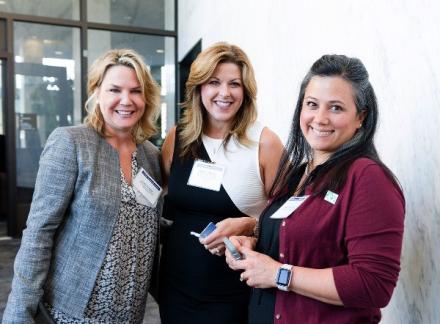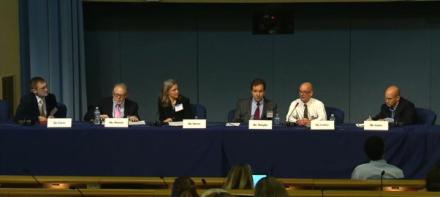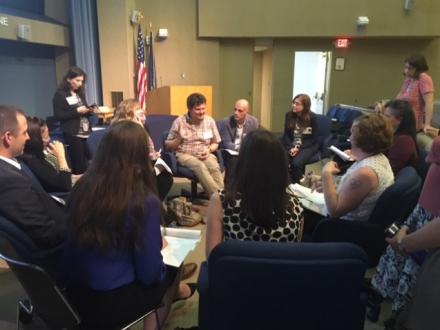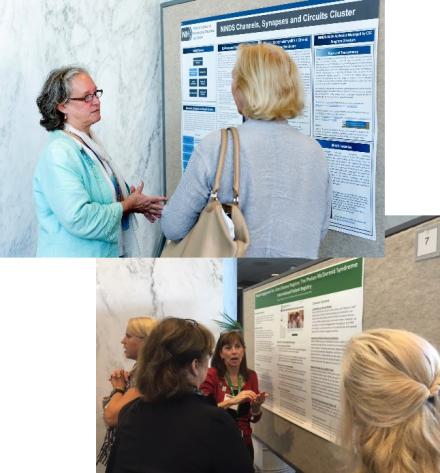This September marked a milestone for the NINDS Nonprofit Forum: its tenth anniversary! The two day forum drew its largest crowd to date with over 150 participants, representing program staff from 3 NIH Institutes, the Food and Drug Administration (FDA), industry, and 75 different nonprofit organizations from across the country.

Each year, the Forum’s theme, “Progress through Partnership,” emphasizes the importance of collaboration between public and private stakeholders to advance therapeutic development for patients with neurological disorders. This theme of collaboration was interlaced throughout each session of the Forum, with several panels focusing on how meaningful clinical data can best be attained, applied, and (most importantly) shared.
The forum kicked off with a panel on Lessons Learned and Case Studies in Natural History Databases moderated by Dr. Petra Kaufmann of the National Center for Advancing Translational Sciences and Ms. Janet Hieshetter of the Dystonia Medical Research Foundation. Panelists discussed their experience developing natural history databases, and the importance of leveraging existing databases that are readily available rather than breaking an organization’s bank account to reinvent the wheel. Dr. Steve Kaminsky from the International Rett Syndrome Foundation recommended starting with the NIH Rare Disease Clinical Research Network, a program designed to advance research on rare diseases that is collecting data from 15 sites around the country in over 40,000 patients to study more than 280 rare diseases.

Once an organization has collected a large amount of data on the natural progression of a disease, it is faced with managing this new resource. To that end, the panel Data Integration and Data Management: Challenges and Opportunities explored the best ways to manage large data networks. Moderated by Mr. Paul Gross of the Hydrocephalus Association, who himself has been involved in the creation of three clinical research networks, this panel focused on opportunities available through integration with Electronic Medical Record (EMR) systems. Dr. Greg Farber from the National Institute of Mental Health described the NIMH Data Archive, which contains over 1,500 measures and a unique identifier generated for each of the more than 100,000 enrolled research participants to link data across studies. In this way, clinical information including results of imaging, genomic, and other experimental data are aggregated and made available to users for analysis
Every disease-related organization, particularly those focused on rare diseases, is familiar with the struggle to identify biomarkers. The panel Strategies for Biomarker Identification asked the common question, “How do you go about developing a biomarker?” Moderated by Drs. Katrina Gwinn and Hao Wang from NINDS, this panel focused on the process of identifying biomarkers in preparing for clinical trial readiness. Dr. Shashi Amur, who coordinates the FDA’s Center for Drug Evaluation and Research Biomarker Qualification Program, described the new FDA-NIH BEST (Biomarkers, Endpoints, and other Tools) Resource, which is a glossary that captures definitions, distinctions, and relationships between biomarkers and clinical assessments. Panelists emphasized that understanding the terminology is a critical first step toward identifying biomarkers.

The panel Developing Better Clinical Outcome Measures was moderated by Mr. Ron Bartek of the Friedreich’s Ataxia Research Alliance. Focused on integrating patient-reported outcomes and wearable technologies into clinical data collection, panelists agreed that technological advancements are paving the way for a brighter future in medicine. Dr. Ray Dorsey of the University of Rochester described the Apple ResearchKit as an example of how new ubiquitous technologies like smartphones are revolutionizing patient recruitment and the ways in which clinical outcome measures are collected. He shared his experience developing the Parkinson mPower app , a collaboration between the University of Rochester and Sage Bionetworks that launched in 2015 to help track Parkinson’s patients’ symptoms. Panelists discussed how new technologies are able to generate incredibly precise data since they allow more sensitive, objective, and continuous disease measurement in natural environments, and that these technologies are increasingly making their way into clinical trials
Dr. Cynthia Rothblum-Oviatt from A-T Children’s Project moderated the panel Cultivating Collaborations on a Shoestring and Investing in the Intellectual Pipeline. Panelists discussed their experiences building a multi-stakeholder network from ground zero, and the best practices for finding, funding, and most importantly retaining researchers in their field of interest. Ms. Tish Hevel introduced the Brain Donor Project , a new nonprofit organization that aims to increase the supply of human post-mortem brains donated for scientific research. By supporting the NIH NeuroBioBank, which collects and distributes human post-mortem brain tissue for research on more than 100 disorders, her organization aims to increase the supply of donated tissue, and thereby help scientists study the underlying cause of neurological disease. Panelists explained that the ‘players’ for successful clinical trials typically include a nonprofit, academic institution, NINDS/NIH, the FDA, and industry.

In addition to our annual “Meet the Program Directors” session where attendees participate in roundtable discussions with NINDS program directors, this year’s Forum introduced something new: an interactive Poster Session. For an hour, attendees were able to learn about 13 scientific programs at NINDS as well as the work being done by several patient groups including the Tuberous Sclerosis Alliance, the Phelan-McDermid Syndrome Foundation, CurePSP, and many more. The poster session gave attendees the opportunity to network and gather information, and it was a great success!
The NINDS Nonprofit Forum would not be possible without our Executive Planning Committee members. This year, I would like to thank the following members from nonprofit organizations: Ron Bartek (Friedreich’s Ataxia Research Alliance), Geraldine Bliss (Phelan-McDermid Syndrome Foundation), Susan Dickinson (Association for Frontotemporal Degeneration), Paul Gross (Hydrocephalus Association), Janet Hieshetter (Dystonia Medical Research Foundation), Ilene Miller (Hope for Hypothalamic Hamartomas), Steve Perrin (ALS Therapy Development Institute), and Cynthia Rothblum-Oviatt (A-T Children’s Project). From NINDS, I would like to thank Marian Emr, Katrina Gwinn, Lyn Jakeman, Jill Morris, Meghan Mott, Marie Rienzo, Margo Warren, Hao Wang, and Alan Willard.
